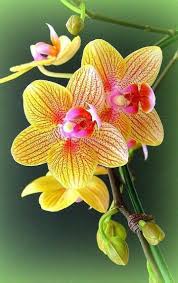# The Impact of Environmental Pollution on the Growth of Dendrobium Anosmum (Phi Diep Orchid)

The Dendrobium anosmum, commonly known as the Phi Diep orchid, is one of the most revered orchids in Southeast Asia, particularly in Vietnam. This stunning plant, celebrated for its beautiful blooms and enchanting fragrance, is not only a symbol of beauty but also a reflection of the delicate balance of its ecosystem. However, like many other plant species, the growth and development of the Phi Diep orchid are increasingly threatened by environmental pollution. This article delves into the various forms of pollution impacting the Dendrobium anosmum, the implications for its growth and health, and potential solutions to mitigate these effects.
## 1. Understanding Dendrobium Anosmum
### 1.1 Description and Characteristics
Dendrobium anosmum is characterized by its long, slender stems and exquisite clusters of flowers, which typically bloom in shades of white, pink, and purple. The plant is epiphytic, meaning it grows on other plants and relies on them for support rather than nutrients. Its unique adaptations allow it to thrive in tropical and subtropical environments, where humidity levels are high, and sunlight is abundant.
### 1.2 Cultural Significance
In Vietnamese culture, the Phi Diep orchid holds deep cultural significance. It symbolizes beauty, resilience, and the connection between nature and humanity. The orchid is often used in traditional ceremonies and is considered a cherished gift, representing good luck and harmony.
## 2. The Effects of Environmental Pollution
Environmental pollution, particularly in urban and industrial areas, poses significant threats to the growth and health of the Dendrobium anosmum. Pollution can take various forms, including air pollution, water pollution, soil contamination, and noise pollution. Each type of pollution can adversely affect the orchid’s growth, leading to diminished health and vitality.
### 2.1 Air Pollution
#### 2.1.1 Sources of Air Pollution
Air pollution primarily arises from industrial emissions, vehicle exhaust, agricultural activities, and the burning of fossil fuels. These pollutants can include particulate matter (PM), sulfur dioxide (SO2), nitrogen oxides (NOx), and volatile organic compounds (VOCs), all of which can significantly impact plant health.
#### 2.1.2 Impact on Dendrobium Anosmum
– **Reduced Photosynthesis**: Pollutants like sulfur dioxide can impair the photosynthesis process in orchids. By reducing the amount of light absorbed by the leaves, air pollution can hinder the plant’s ability to produce energy, ultimately affecting its growth.
– **Respiratory Issues**: Like many plants, Dendrobium anosmum has stomata on its leaves that allow for gas exchange. Pollutants can clog these stomata, leading to respiratory issues for the plant and limiting its growth potential.
– **Stress Response**: Prolonged exposure to air pollutants can induce stress responses in the Phi Diep orchid, making it more susceptible to diseases and pests. This stress can lead to stunted growth, leaf discoloration, and decreased flowering.
### 2.2 Water Pollution
#### 2.2.1 Sources of Water Pollution
Water pollution can result from agricultural runoff, industrial discharges, sewage, and plastic waste. Contaminants such as heavy metals, pesticides, and fertilizers can leach into water bodies, posing a risk to aquatic and terrestrial ecosystems.
#### 2.2.2 Impact on Dendrobium Anosmum
– **Toxicity**: The presence of heavy metals like lead, cadmium, and mercury in water can be toxic to Dendrobium anosmum. These metals can accumulate in the plant tissues, leading to various physiological problems and potentially reducing its lifespan.
– **Nutrient Imbalance**: Excessive use of fertilizers can lead to nutrient imbalances in the water supply. While Dendrobium anosmum requires specific nutrients for growth, an overload can result in nutrient toxicity, disrupting the plant’s growth and development.
– **Root Rot**: Polluted water can affect the health of the orchid’s root system. Contaminated water may promote the growth of pathogens and fungi, leading to root rot, which can be fatal for the plant.
### 2.3 Soil Contamination
#### 2.3.1 Sources of Soil Contamination
Soil contamination can occur due to the deposition of hazardous waste, agricultural chemicals, and industrial byproducts. Pesticides, herbicides, and heavy metals can accumulate in the soil, affecting its quality and the health of plants growing in it.
#### 2.3.2 Impact on Dendrobium Anosmum
– **Nutrient Depletion**: Contaminants can alter the soil composition, leading to nutrient depletion. Dendrobium anosmum requires specific nutrients for optimal growth; without them, the plant may struggle to thrive.
– **Soil pH Alteration**: Contaminants can also affect soil pH levels. Dendrobium anosmum prefers slightly acidic to neutral soil conditions. Significant changes in pH can hinder nutrient uptake, affecting overall plant health.
– **Root Development Issues**: Contaminated soil can impede root development, limiting the orchid’s ability to absorb water and nutrients effectively. A weak root system can lead to stunted growth and increased vulnerability to environmental stressors.
### 2.4 Noise Pollution
#### 2.4.1 Sources of Noise Pollution
Noise pollution primarily arises from urbanization, industrial activities, and transportation systems. While it may seem less impactful than other forms of pollution, it can still affect plant life.
#### 2.4.2 Impact on Dendrobium Anosmum
– **Stress and Growth Inhibition**: Studies suggest that prolonged exposure to high noise levels can induce stress responses in plants. This stress can lead to inhibited growth and reduced flowering in Dendrobium anosmum.
– **Disruption of Pollination**: Noise pollution can disrupt the natural behaviors of pollinators. As the Phi Diep orchid relies on specific pollinators, such as bees, to reproduce, disruptions in pollinator activity can hinder its reproductive success.
## 3. The Broader Implications of Pollution on Orchid Conservation
### 3.1 Threats to Biodiversity
The degradation of habitats due to environmental pollution poses a severe threat to biodiversity. The Phi Diep orchid, along with other orchid species, faces increasing pressure from habitat loss and pollution, contributing to declining populations.
### 3.2 Economic Implications
Orchids, including Dendrobium anosmum, hold significant economic value in the floral industry. As pollution affects their growth and health, it can lead to decreased availability and increased prices, impacting both producers and consumers.
### 3.3 Cultural Loss
In cultures where the Phi Diep orchid holds symbolic significance, the decline of this species due to pollution can lead to cultural losses. The absence of such iconic plants can diminish traditional practices and ceremonies associated with their beauty and significance.
## 4. Mitigation Strategies
To address the impact of environmental pollution on Dendrobium anosmum and other orchids, a multifaceted approach is required. Here are some strategies that can be implemented:
### 4.1 Sustainable Agricultural Practices
Encouraging sustainable agricultural practices can help reduce chemical runoff into water systems. Implementing organic farming techniques, crop rotation, and integrated pest management can minimize the use of harmful pesticides and fertilizers.
### 4.2 Pollution Control Measures
Strengthening pollution control regulations for industries and urban areas can help mitigate air and water pollution. Regular monitoring and enforcement of environmental standards can reduce the release of harmful substances into the environment.
### 4.3 Public Awareness Campaigns
Raising public awareness about the importance of orchids and their role in ecosystems can encourage conservation efforts. Educational campaigns can promote responsible gardening practices and the importance of protecting natural habitats.
### 4.4 Restoration of Natural Habitats
Restoring degraded habitats can provide a safer environment for Dendrobium anosmum and other orchids. Reforestation, wetland restoration, and soil remediation efforts can help reestablish healthy ecosystems.
### 4.5 Support for Orchid Conservation Programs
Supporting local and international orchid conservation programs can play a vital role in protecting species like the Phi Diep orchid. These programs often focus on habitat preservation, breeding, and reintroduction efforts.
## 5. Conclusion
The Dendrobium anosmum, or Phi Diep orchid, is a stunning symbol of beauty and resilience. However, its growth and health are increasingly threatened by environmental pollution, which takes various forms and has far-reaching implications. By understanding the impact of pollution on this cherished species and implementing effective mitigation strategies, we can work towards preserving the Phi Diep orchid for future generations.
Protecting the Dendrobium anosmum is not just about conserving a beautiful plant; it is about maintaining biodiversity, cultural heritage, and the delicate balance of our ecosystems. Through collective efforts, we can ensure that this exquisite orchid continues to thrive and inspire generations to come.

